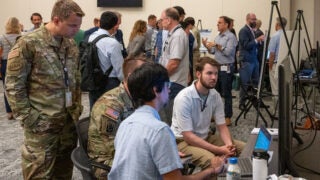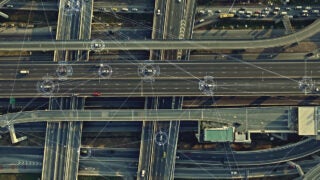
Snail larva drawings done by participants in the enrichment classes led by USC students. (Images/Courtesy of Linda Chilton)
USC Sea Grant program helps L.A. kids become young scientists and engineers
“Storytime with a Scientist” is just one of many university initiatives that teach local students about the wonders of the scientific world.
When his classes went remote last spring, fifth grader Benjamin Santos felt like learning had lost its spark. But after attending a Zoom session about the perseverance of the Super Soaker’s inventor, he feels the spark has returned.
The meeting was part of USC Sea Grant’s monthly “Storytime with a Scientist” virtual learning series that allows students in the Los Angeles Unified School District to engage with scientists remotely. So far, the program has hosted several experts, including Miguel Ordenena of the Natural History Museum of Los Angeles County to discuss a biologist-tracked mountain lion that lives in Los Angeles, as well as Melody Aleman, a doctoral candidate in microbiology at USC who spoke with the children about the world of microbes.
The students have gotten the chance to hear more about women scientists who have made history, including the Nobel Prize-winning physicist Marie Curie and American geologist and oceanographic cartographer Marie Tharp, who created the first map of the Atlantic Ocean floor.
“Storytime with a Scientist” is an initiative of the Sea Grant enrichment program at the USC Dornsife College of Letters, Arts and Sciences. It aims to provide students from the communities surrounding USC and beyond with science, engineering, technology and mathematics — also known as STEM — experiences that prompt their curiosity and encourage them to investigate and explore using scientific thinking. This opportunity went virtual this year due to the pandemic, and it was made possible by 27 organizations that banded together to find ways for students to explore and apply STEM practices from their homes.
Program leaders are aiming for the children to see themselves as scientists, technologists, engineers and mathematicians, said Linda Anne Chilton, the education program coordinator for USC Sea Grant.
USC Sea Grant created the educational program because both experience and research show that if students don’t know anyone in the STEM fields and have very few STEM experiences in early grades, they are significantly less likely to pursue a STEM degree when they go to college. Without this program, there would be no opportunity for elementary and middle school students to participate in STEM education during this time of virtual learning. A major element of the program is recognizing education doesn’t just happen in schools but in partnerships with the community.
Sea Grant program introduces local students to STEM
As part of the Sea Grant program, fifth graders developed and carried out experiments with the lab at the USC Wrigley Marine Science Center on Catalina Island to understand how plants gain mass. This spring, middle schoolers developed bioengineered solutions using the adaptations they learned from studying intertidal life at Catalina, and high schoolers studied plastics and learned more about alternatives in the lab of Megan Fieser.
Based on the students’ responses, the program has succeeded in instilling a scientific mindset. Fifth grader Stephanie Acabal said the Sea Grant program is an open and interactive way to learn more about topics she loves. She finds it more engaging than her regular classes because she gets to communicate with scientists who are studying the things she’s interested in. Brianna Burgess feels that the program significantly enhances what she learns in her classes because it gives her extra knowledge whenever the topics in class and storytime align.
Not only have students found a newfound interest in the topics covered in the storytimes, but they’ve also inspired a curiosity about other science topics. Dayanna Vielman said she is curious to learn more about chemical properties and how they change. Allan Lopez said he wants to study Homo sapiens and botany because for him, “learning about our past and how we evolve is really interesting.” And Kimberly Hernández said she wants to combine her interests in mysteries and science to learn more about the psychology of crime.
Chilton said participants are “starting to think about themselves more as an engineer, an inventor or a designer,” rather than just as students. While the program is STEM-focused, she noted that there’s an element of social-emotional learning as well.
Students are learning ways to “express feelings and concern,” she said, “and tying it also to the natural world and what they’re exploring.”



